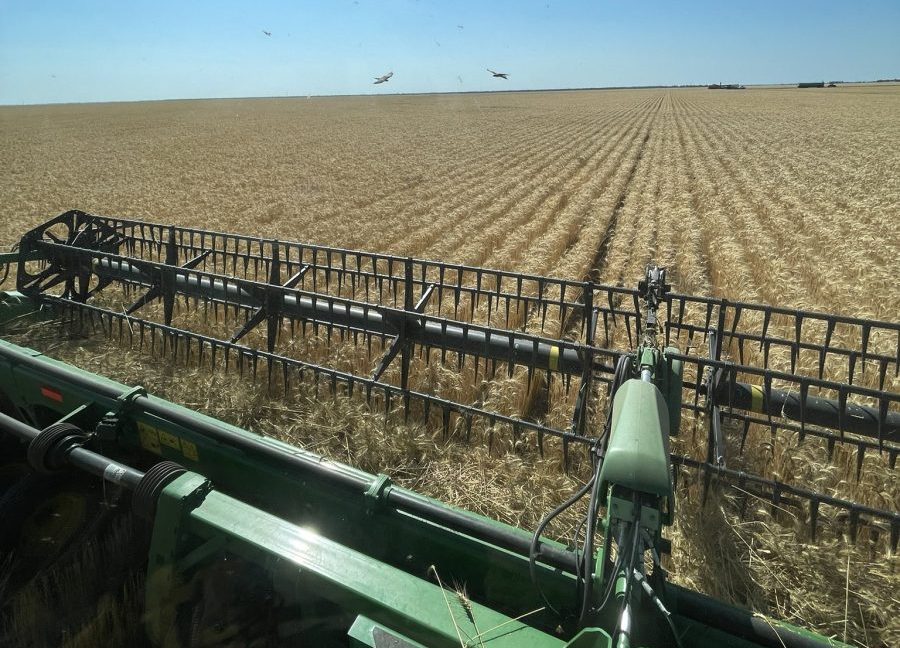
Harvesting wheat this week north of Clermont in CQ. Photo: Brad Hallion
THE collapsing protein outlook for Australia’s wheat has domestic and export buyers of new crop largely sitting out of the market as harvest cranks up.
It is already under way for wheat in Central Queensland (CQ) and canola in Western Australia’s Geraldton zone, and volume wheat and barley is expected to hit the bins in Queensland from mid-October.
A proliferation of wheat cargoes on nearby export stems indicates demand is hot for Australian wheat, helped by the weaker Australian dollar, but offset by recessionary concerns in many global economies.
While growers and traders are aware the La Niña event could well slow harvest and haulage, big stocks in New South Wales and WA are providing a buffer for consumers and exporters.
| Prompt | Sep 23 | New-crop | Sep 23 | |
| Barley Downs | $370 | $375 | $370 | $375 |
| SFW wheat Downs | $375 | $380 | $392 | $385 |
| Sorghum Downs | $365 | $370 | $345 | $350 |
| Barley Melbourne | $368 | $370 | $368 | $360 |
| ASW Melbourne | $420 | $402 | $440 | $418 |
| SFW Melbourne | $400 | $380 | $400 | $380 |
Table 1: Indicative prices in Australian dollars per tonne.
Northern protein pressured
Prices for barley and prompt wheat have eased by around $5 per tonne in the past week amid very thin trade, while the new-crop wheat market has firmed slightly based on increased competition for exports delivered to the port of Brisbane.
Based on outstanding yield prospects in many regions, unofficial estimates put the Queensland wheat crop comfortably above the record 2 million tonnes (Mt) harvested in 2008-09 from 1M hectares.
ABARES has estimated Queensland’s 2022-23 wheat area at 746,000ha, down from 829,000ha last year which yielded 1.8Mt, and excellent growing conditions have seen some early CQ crops yield 4.5-5t/ha, close to double the average.
ABARES’ most recent Queensland wheat estimate for the 2022-23 crop of 1.7Mt was released early this month, and does not factor in the mild and wet month to date which has bolstered yield potential.
“We could pull off 2.5-2.8Mt and that would be a record,” one trade source said.
CQ usually gets a dry finish to its growing season, and traditionally produces mostly Hard and Prime Hard wheat.
However, early indications are that the lower-protein Australian Standard White (ASW) and Australian Premium White (APW) grades will be well up on average as a proportion of the crop.
“If CQ is getting ASW and APW, that’s a signal for the rest of the harvest.”
“The market’s hard to define; it’s really quiet.”
At Narrabri, Priag Marketing principal Kevin Schwager said growers who put sufficient nitrogen on their crops were likely to see a reward as the spread for protein over base grades widens.
“Whether we’re going to get the protein, the jury is out on that one,” Mr Schwager said.
Uncertainty about the weather into harvest and what it will do to quality has quashed grower interest in forward selling, regardless of price levels.
“They’ll go into harvest before they price too much more.
“Growers are nervous on quality, given the weather they’ve experienced, and it’s a major reason for holding back on their new-crop marketing.”
Some domestic consumers have been out of the market for weeks, comfortable in the knowledge that new-crop barley and low-protein wheat will be available in abundance by the end of next month.
Most of Queensland’s grain-growing regions had falls of rain in the single-digits, if any, in the week to 9am today, with Emerald on 6 millimetres and Macalister on 10mm among the highest.
Most of NSW was happy to have a dry week, but storms brought scattered falls, with heaviest registrations including: Manildra 18mm; Morundah 49mm; Temora 23mm, Quirindi 50mm and West Wyalong 14mm.
South shapes up
In the southern market, consumers are aware of yield potential which ranges from above average to record, and are therefore in no hurry to buy.
They are also snapping up loads here and there as growers and traders run down their carry-out stocks ahead of harvest.
Rain in the past week, which brought mostly 10-40mm to parts of the Mallee and Wimmera, is further improving yield prospects.
“There’s no liquidity in the market because there’s very little grower engagement,” a trader said.
Anecdotal evidence puts south-eastern Australia’s barley crop at well down on average, the impact largely of expanded canola area.
With fertiliser prices so high this year, trade sources say the nutritional needs of wheat and canola have been prioritised.
“If you were going to feed a crop, you’d feed wheat and canola.”
“I think the barley crop has been overestimated; the area planted is a lot lower than we first thought, and inputs have been skimped on.
“We’re going to see the impact of both those things in the size of the crop.”
Old-crop grain is still available, but largely at sites well away from port or hubs for domestic consumption.
“All of the low-hanging fruit has gone, and what’s left is far in excess of where you’d like to be picking it up from.”
Wheat is still in hot demand from exporters, and stems indicate shipments will roll into new crop without a break.
“The wheat margins are skinnier than they have been, but wheat’s going to keep buying the stem.”

HAVE YOUR SAY